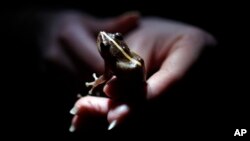Researchers have developed software that can listen to recordings of a rainforest and tell us what animals are there, and importantly, what animals are not. The new technology is free online for anyone to use and conservationists are taking advantage of it.
If you listen closely to a recording of a rainforest in Puerto Rico, you probably will not be able to count how many frogs you hear. Unfortunately, one of those frogs - the one with the really high-pitched chirps, like tapping on glass - is called a Plains Coqui, and it is endangered.
Scientists struggle with this problem every day. Thousands of species die out each year, and they want to know how climate change and habitat destruction are affecting animals like the Plains Coqui. But how can scientists know if they’re dying out if they don’t even know how many there are?
That’s where the Automated Remote Biodiversity Monitoring Network, or ARBIMON, comes in.
“It’s a generic system to monitor biodiversity," said Mitchell Aide of the University of Puerto Rico, who is one of the leaders of the ARBIMON team. The team has developed new technology that could help conservationists monitor biodiversity worldwide.
"The software is set up for the user to use it for whatever species they’re interested in, it could be snapping shrimp, or whales, or it could be frogs or insects or monkeys,” Aide added.
Researchers place small, inexpensive sound recorders - often reprogrammed iPods - in the rainforest, where they take short sound samples every 10 minutes around the clock. The recordings are sent in real time to a central computer.
The scientists program the computer to recognize the sounds of different animals in the recordings, and then they let the software run. It can analyze tens of thousands of recordings in less than an hour, and tell researchers which animals are in the rainforest, which aren’t, who’s making sounds when and who’s not.
For example, when researchers looked at five years of recordings in Puerto Rico, they noticed that the endangered frog called less and less over four years. This could be cause for alarm, but in the fifth year the frog's appearance in the samples bounced back to its original levels. This information about what appears to be the frog population's natural rhythm would not have been available without long-term data.
The team now has recording stations in Hawaii, Arizona, Costa Rica, Brazil and many other locations. Over months or even years, Aide says scientists can build a sound picture of the landscape, and what lives there.
“We’re creating a permanent record," he said. "In a sense, each recording is the equivalent of a specimen in a museum. We’re going to archive these recordings so anybody can have access to them today, or in five years, or in 20 years, and go back and say, ‘What were the sounds like in this forest, in this city, on this island, 15, 20 years ago?’”
The ARBIMON software and its archive of sound is freely available to everyone, scientists and citizens alike, at arbimon.com.
If you listen closely to a recording of a rainforest in Puerto Rico, you probably will not be able to count how many frogs you hear. Unfortunately, one of those frogs - the one with the really high-pitched chirps, like tapping on glass - is called a Plains Coqui, and it is endangered.
Scientists struggle with this problem every day. Thousands of species die out each year, and they want to know how climate change and habitat destruction are affecting animals like the Plains Coqui. But how can scientists know if they’re dying out if they don’t even know how many there are?
That’s where the Automated Remote Biodiversity Monitoring Network, or ARBIMON, comes in.
“It’s a generic system to monitor biodiversity," said Mitchell Aide of the University of Puerto Rico, who is one of the leaders of the ARBIMON team. The team has developed new technology that could help conservationists monitor biodiversity worldwide.
"The software is set up for the user to use it for whatever species they’re interested in, it could be snapping shrimp, or whales, or it could be frogs or insects or monkeys,” Aide added.
Researchers place small, inexpensive sound recorders - often reprogrammed iPods - in the rainforest, where they take short sound samples every 10 minutes around the clock. The recordings are sent in real time to a central computer.
The scientists program the computer to recognize the sounds of different animals in the recordings, and then they let the software run. It can analyze tens of thousands of recordings in less than an hour, and tell researchers which animals are in the rainforest, which aren’t, who’s making sounds when and who’s not.
For example, when researchers looked at five years of recordings in Puerto Rico, they noticed that the endangered frog called less and less over four years. This could be cause for alarm, but in the fifth year the frog's appearance in the samples bounced back to its original levels. This information about what appears to be the frog population's natural rhythm would not have been available without long-term data.
The team now has recording stations in Hawaii, Arizona, Costa Rica, Brazil and many other locations. Over months or even years, Aide says scientists can build a sound picture of the landscape, and what lives there.
“We’re creating a permanent record," he said. "In a sense, each recording is the equivalent of a specimen in a museum. We’re going to archive these recordings so anybody can have access to them today, or in five years, or in 20 years, and go back and say, ‘What were the sounds like in this forest, in this city, on this island, 15, 20 years ago?’”
The ARBIMON software and its archive of sound is freely available to everyone, scientists and citizens alike, at arbimon.com.














